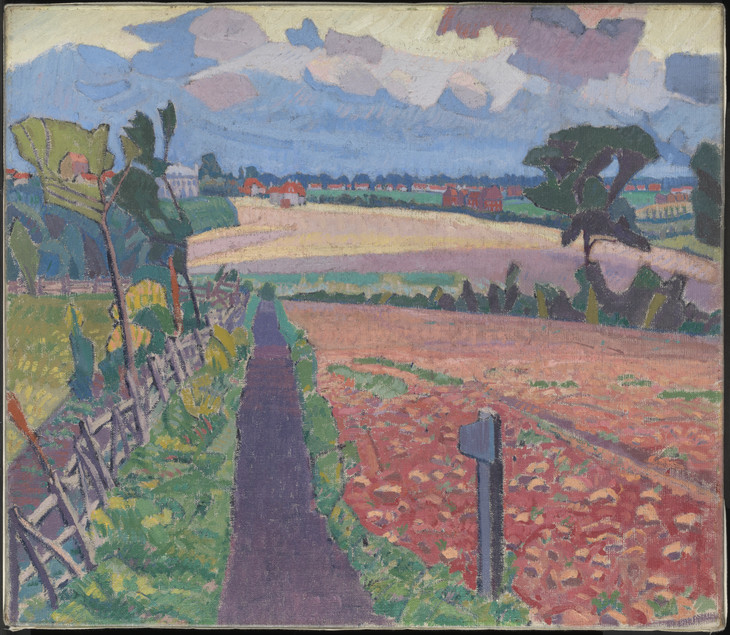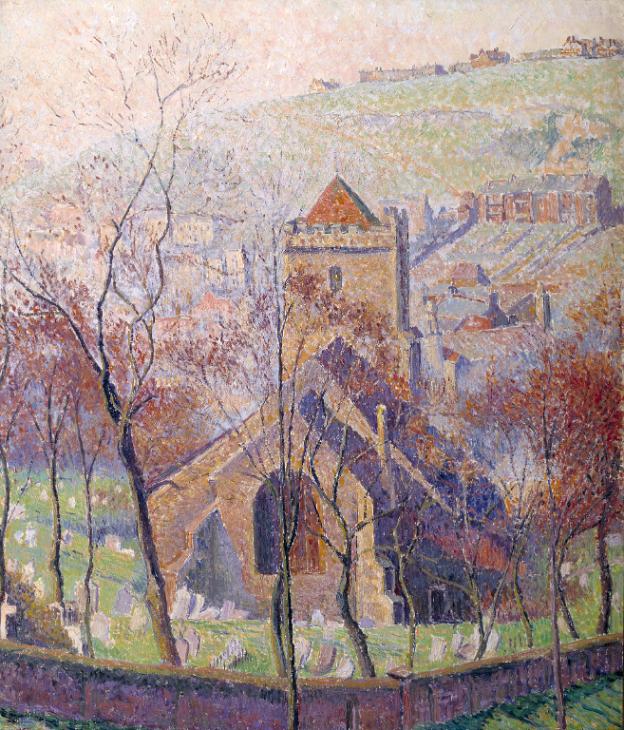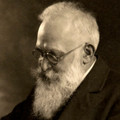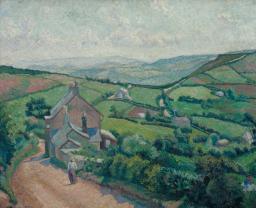Lucien Pissarro All Saints' Church, Hastings: Sun and Mist 1918
Lucien Pissarro,
All Saints' Church, Hastings: Sun and Mist
1918
Pissarro’s view looks out from what is now East Hill in Hastings Country Park in Sussex, close to his residence at 2 High Wickham. All Saints’ is one of two medieval churches in the town of Hastings, visible in the painting through the foggy mist in the valley. The strong red of the church tower’s pyramidal roof is repeated in the warmer tones of distant brick buildings, autumn foliage and the cemetery’s perimeter wall.
Lucien Pissarro 1863–1944
All Saints’ Church, Hastings: Sun and Mist
1918
Oil paint on canvas
648 x 533 mm
Inscribed ‘LP’ in monogram and ‘1918’ bottom left, and ‘All Saints Church Hastings (Sun + Mist)’ in pencil on stretcher top member
Presented by the Trustees of the Chantrey Bequest 1934
N04748
1918
Oil paint on canvas
648 x 533 mm
Inscribed ‘LP’ in monogram and ‘1918’ bottom left, and ‘All Saints Church Hastings (Sun + Mist)’ in pencil on stretcher top member
Presented by the Trustees of the Chantrey Bequest 1934
N04748
Ownership history
Purchased from the artist by the Trustees of the Chantrey Bequest 1934, by whom presented to Tate Gallery.
Exhibition history
1918
Fifty-Ninth Exhibition of Modern Pictures held by the New English Art Club, The Gallery, Suffolk Street, London, Summer 1918 (125, as ‘All Saints’ Church, Hastings’).
1920
First Monarro Group Exhibition, Goupil Gallery, London, February 1920 (124).
1920
Retrospective Exhibition of Paintings and Drawings by Lucien Pissarro, Hampstead Art Gallery, London, October–November 1920 (13).
1924
Pissarro et ses fils, Galerie Marcel Bernheim, Paris, January–February 1924 (22).
1924
Modern British Art, Goupil Gallery, London, Summer 1924 (186).
1928
Lucien Pissarro, Ruskin Gallery, Birmingham, January–February 1928 (13).
1933
Spring Exhibition, Cartwright Memorial Hall, Bradford 1933 (94).
1934
Summer Exhibition, Royal Academy, London, May–August 1934 (351).
1935–6
Paintings and Drawings by Lucien Pissarro, (Art Exhibitions Bureau tour), City of Manchester Art Gallery, June–July 1935 (26), Williamson Art Gallery, Birkenhead, July–August 1935 (25), County Borough of Burton upon Trent Museum and Art Gallery, February 1936 (26), City of Belfast Museum and Art Gallery, May–June 1936 (27), Corporation Art Gallery, Rochdale, June–July 1936 (27), Shipley Art Gallery, Gateshead, August 1936 (27).
1946–7
Modern British Pictures from the Tate Gallery, (British Council tour), Palais des Beaux-Arts, Brussels, January–February 1946 (68), Stedelijk Museum, Amsterdam, March 1946 (68), Raadhushallen, Copenhagen, April–May 1946 (68), Musée du Jeu de Paume, Paris, June–July 1946 (68), Musée des Beaux-Arts, Berne, August 1946 (70), Akademie der Bildenden Kunste, Vienna, September 1946 (71), Narodni Galerie, Prague, October–November 1946 (71), Muzeum Narodwe, Warsaw, November–December 1946 (71), Galleria D’Arte Moderna, Rome, January–February 1947 (71), Tate Gallery, London, May–September 1947 (4748).
1949
The Chantrey Collection, Royal Academy, London, January–March 1949 (215).
1950
Works from the Chantrey Collection, Lady Lever Art Gallery, Port Sunlight, Cheshire, July–September 1950 (61, as ‘All Saints Church, Hastings’).
1958
A Selection from the Chantrey Bequest, Graves Art Gallery, Sheffield, April 1958 (58).
1963
Lucien Pissarro 1863–1944: A Centenary Exhibition of Paintings, Watercolours, Drawings and Graphic Work, (Arts Council tour), Arts Council Gallery, London, January–February 1963, Manchester City Art Gallery, March 1963, Bristol City Art Gallery, April 1963, Dundee City Art Gallery, May 1963, The Minories, Colchester, June 1963, Ashmolean Museum, Oxford, July 1963 (40).
1965–78
Salford Art Gallery, May 1965–April 1978 (long loan).
1989
Lucien and Orovida Pissarro, Hastings Museum and Art Gallery, September–October 1989 (1, as ‘All Saints Church, Hastings: Sun & Mist’, reproduced).
1993
The Sussex Scene: Artists in Sussex in the Twentieth Century, Hove Museum and Art Gallery, July–August 1993, Towner Art Gallery, Eastbourne, August–October 1993 (100, as ‘Hastings: All Saints Church: Sun and Mist’).
References
1920
Queen, 13 March 1920, p.336.
1920
‘A Review of Impressionism: The Monarro Aftermath of the Impressionists Movement at the Goupil Gallery Exhibition’, Vogue, late March 1920, reproduced p.76.
1920
Frank Rutter, The Galleries: The Monarro Group’, Sunday Times, 15 February 1920, p.6.
1962
W.S. Meadmore, Lucien Pissarro: Un Coeur Simple, London 1962, pp. 161–2.
1983
Anne Thorold, A Catalogue of the Oil Paintings of Lucien Pissarro, London 1983, no.275, reproduced p.137.
1999
Frances Stenlake, From Cuckfield to Camden Town: The Story of Artist Robert Bevan, Cuckfield 1999, p.55.
Technique and condition
All Saints’ Church, Hastings: Sun and Mist has been painted on a flat white ground which shows in some places. The commercial pre-primed canvas is stamped ‘(Percy) Young 37 Gower St’.
Pissarro has increased the directional linear style of his painting, initially drawn in dark blue paint. There are strong brushmarks going in both diagonal directions, and the composition is also diagonal. It is painted with solid, opaque colours with no glazes, and the darker colours contrast strongly. There are several colour campaigns; the last one is blue grey for the mists, which was applied after the trees.
There is less careful finishing of forms than in earlier work. The building’s more impressionist shadows are even and flat in the area of the church, while the tree to the left of the tower interrupts the space.
Stephen Hackney
June 2003
How to cite
Stephen Hackney, 'Technique and Condition', June 2003, in David Fraser Jenkins, ‘All Saints’ Church, Hastings: Sun and Mist 1918 by Lucien Pissarro’, catalogue entry, October 2002, in Helena Bonett, Ysanne Holt, Jennifer Mundy (eds.), The Camden Town Group in Context, Tate Research Publication, May 2012, https://wwwEntry
The ‘mist’ of the title is seen at the left, in the middle distance behind the trees in the bottom of the valley, towards the main part of Hastings Old Town which is also down to the left. The mist is being cleared at the right by the bright sunlight, which falls on the church and the hillside behind it. The overall pink tonality is centred on the strong red of the church tower’s pyramid roof, and many of the buildings are reddish. The church is defined by strong shadows, as the light falls from behind the artist to the left. The screen of trees in the foreground was painted before the detail behind it, which is fitted in around the branches.

Spencer Gore 1878–1914
The Cinder Path 1912
Oil paint on canvas
support: 686 x 787 mm; frame: 815 x 924 x 73 mm
Tate T01960
Purchased 1975
Fig.1
Spencer Gore
The Cinder Path 1912
Tate T01960
Pissarro’s work on the painting is detailed in one of his diaries.2 He used them to record his work and travels as if talking to himself, with exclamation marks at the exciting bits. Much of each diary is blank, suggesting that he only wrote when he was away from home on a painting expedition. Of those that have survived, only two cover the period of any of Tate’s five paintings, but these each include a daily record of his work. In the 1918 diary he notes his arrival at Hastings on 11 January, and continues:
19 January. At last my picture boxes have arrived! I will be able to work.
24 January. Afternoon had a look round – saw beautiful subject with church in foreground, but as the sea is in the distance I am not supposed to paint it. I must try to work it from memory.
24 January. Afternoon had a look round – saw beautiful subject with church in foreground, but as the sea is in the distance I am not supposed to paint it. I must try to work it from memory.
His first paintings were taken looking through the window of his house, including one view he called Sun and mist.3 In March he began the Tate painting, referring to the picture by its French canvas size as a ‘T.15’, which was 65 x 54 cm:
11 March. Morning started on a T.15 sunny effect the Old Church (I)
12 March. Morning. partly covered T.15 sunny effect Old Church (II)
15 March. Morning. finish covering T.15 Sunny effect Old Church (III)
18 March. morning. worked at Sunny effect T.15 Old Church (IV). been stoned for the first time
20 March. morning. worked at Sunny effect T.15 Old Church (V)
21 March. Morning worked at Sunny effect T.15 Old Church (VI)
22 March. Morning. Had a splendid effect with sun and slight mist in the background, thought I was going to put the Old Church on its legs VII. Started to work half demolish the thing and then the sun desapeared and the mist change into an impenetrable fog! Damn it all!!!
23 March. Morning. Same effect than yesterday but steadier worked at the old church VIII tho’ it was Saturday.
24 March. Morning same effect for the 3rd day running so worked at the Old Church (IX) the picture is out of the wood only foreground to complete
25 March. Alas. wrong weather – east wind, had no sun, could not complete the old church!
26 March. Morning had a go at Old Church, worked foreground, but could not finish it (X) have to leave it behind
27 March. go to London with OCP
12 March. Morning. partly covered T.15 sunny effect Old Church (II)
15 March. Morning. finish covering T.15 Sunny effect Old Church (III)
18 March. morning. worked at Sunny effect T.15 Old Church (IV). been stoned for the first time
20 March. morning. worked at Sunny effect T.15 Old Church (V)
21 March. Morning worked at Sunny effect T.15 Old Church (VI)
22 March. Morning. Had a splendid effect with sun and slight mist in the background, thought I was going to put the Old Church on its legs VII. Started to work half demolish the thing and then the sun desapeared and the mist change into an impenetrable fog! Damn it all!!!
23 March. Morning. Same effect than yesterday but steadier worked at the old church VIII tho’ it was Saturday.
24 March. Morning same effect for the 3rd day running so worked at the Old Church (IX) the picture is out of the wood only foreground to complete
25 March. Alas. wrong weather – east wind, had no sun, could not complete the old church!
26 March. Morning had a go at Old Church, worked foreground, but could not finish it (X) have to leave it behind
27 March. go to London with OCP
OCP was his daughter Orovida Camille Pissarro.
Pissarro was back in Hastings the following month, and evidently took the painting to the site again to finish it:
25 April. finished Old Church at last! (XI).
The painting took eleven mornings from start to finish, with each working session numbered in Roman letters, though he did not do this with other paintings in the diary. He first of all covered the whole surface with paint, presumably after an outline drawing, but then worked for most of the time after this principally to represent the effect of light. His more ambitious paintings of Hastings were always done in the morning, as he only worked on site, and always needed a similar light. In the afternoons he made sketches, and walked about looking for new subjects.
Pissarro drew this church in one of his sketchbooks as it appears in the painting.4 Hard and soft pencils were contrasted to make a tonal effect of light, with an emphasis on the light and shadow on top of the tower’s pyramidal roof. This sketchbook has many drawings of Hastings, some of them panoramas looking across the town, only a few of which were made into paintings. Each view is drawn once only, and he does not sketch details or play with slightly different views: it is as if he were taking a photograph, complete in a single snapshot. It is a reminder of the suspicious attitudes towards landscape artists during the war that he could not paint the first view of the church that he wanted to as the sea was included: there was a rule against this, intended to prevent spying. His being stoned on 18 March may be connected with a local feeling against foreigners, as although he became a British citizen in 1916 he must have still appeared and spoken like a Frenchman. The war was close to the town, and on 29 April he noted that, ‘A boat had been sunk by a mine or a submarine off Hastings’.
With his friend J.B. Manson, Pissarro organised a new group of artists dedicated to the principles of impressionism, who showed together for the first time at the Goupil Gallery in 1920. He was still visiting the elderly Claude Monet at Giverny (who died in 1926), and seeing his mother at Eragny outside Paris; and in honour of this older generation he invented the name ‘Monarro Group’ (conflating Monet’s and Camille Pissarro’s surnames). Included in the first exhibition were works by Paul Signac, Pierre Bonnard, his own family, and some British artists. The press reviews were plentiful, and critics leapt at the chance to compare Camille and Lucien. The critic Frank Rutter suggested that All Saints’ Church improved on Camille’s painting with its ‘greater vivacity and brilliance of colour’ and his painting generally is ‘closer knit in structure, firmer and stronger in design’.5 The critic of Vogue focused on this painting as Lucien’s best, but nevertheless blamed both generations of artists for inventing a laborious technique which cut out the emotional effects of spontaneity:
Mr Lucien Pissarro, with perfect filial devotion, has remained faithful to his father’s ideals. So that even though he has not produced as perfect an example of that teaching as Camille’s Coin de Pré, his All Saints Church, Hastings (124) is delightful. But even in this one recognises that a method of painting which is so dependant on elaborate and protracted handling must lose in emotion. By the time that the painter in this method has completed his intricate formula, involving countless little dabs of colour to the square inch, the emotion that he felt en premier coup, must have appreciably faded. So, inevitably perhaps, his picture wears the dry ungenerous air of a dispassionate schedule, rather than the stamp of spontaneity borne by even an imperfect sketch, swept in on a gust of vehement inspiration.6
There was only one other exhibition of the Monarro Group, again at the Goupil Gallery, the following year.
The painting was subsequently selected for several exhibitions, at first by the artist before he sold it. It was clearly a painting of which he was proud. In 1922 he sent it to Pittsburgh to the jury of the Carnegie International exhibition, but it was rejected. Although he did show other pictures at Pittsburgh, his work has rarely been chosen for group exhibitions, except as part of his family, or as part of the Chantrey Collection. It can be argued that this indicates his ambiguous position between British and French art, and between impressionist and modern art.
David Fraser Jenkins
October 2002
Notes
Nikolaus Pevsner, The Buildings of England, Sussex, East Sussex, Harmondsworth 1965, 1970 edn, p.519.
Probably Hastings: Mist, Sun and Smoke, Ashmolean Museum, Oxford, in Anne Thorold, A Catalogue of the Oil Paintings of Lucien Pissarro, London 1983, no.270.
Related biographies
Related catalogue entries
How to cite
David Fraser Jenkins, ‘All Saints’ Church, Hastings: Sun and Mist 1918 by Lucien Pissarro’, catalogue entry, October 2002, in Helena Bonett, Ysanne Holt, Jennifer Mundy (eds.), The Camden Town Group in Context, Tate Research Publication, May 2012, https://www






